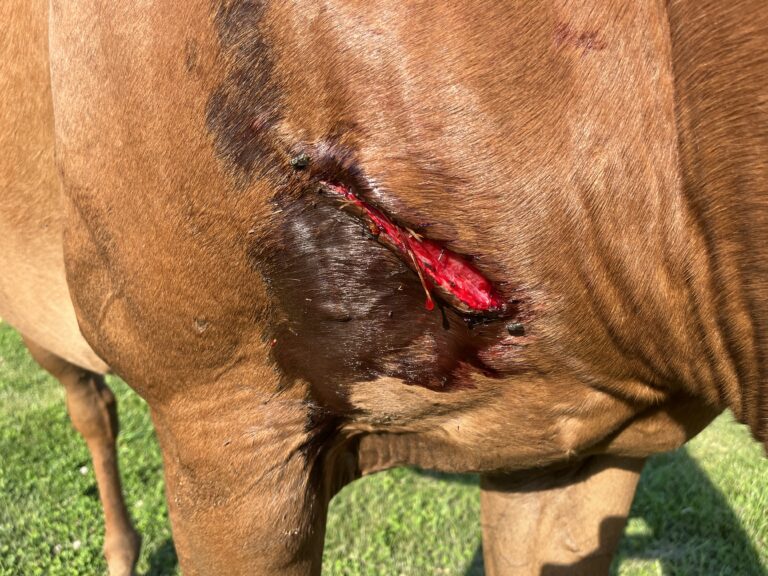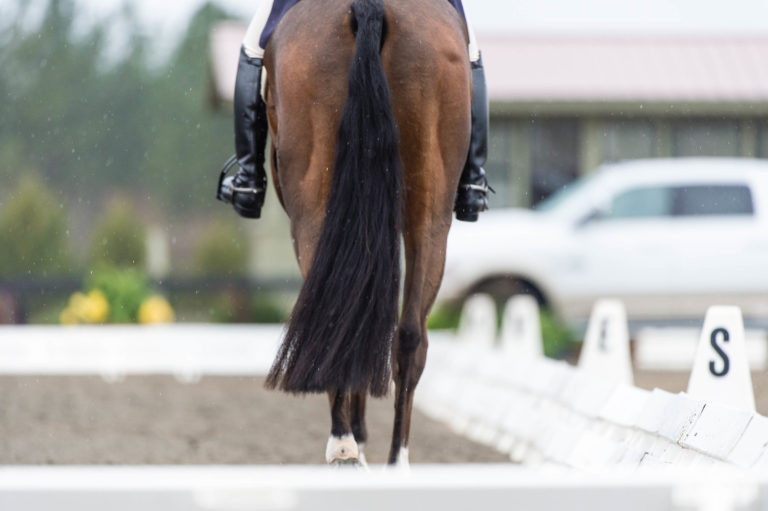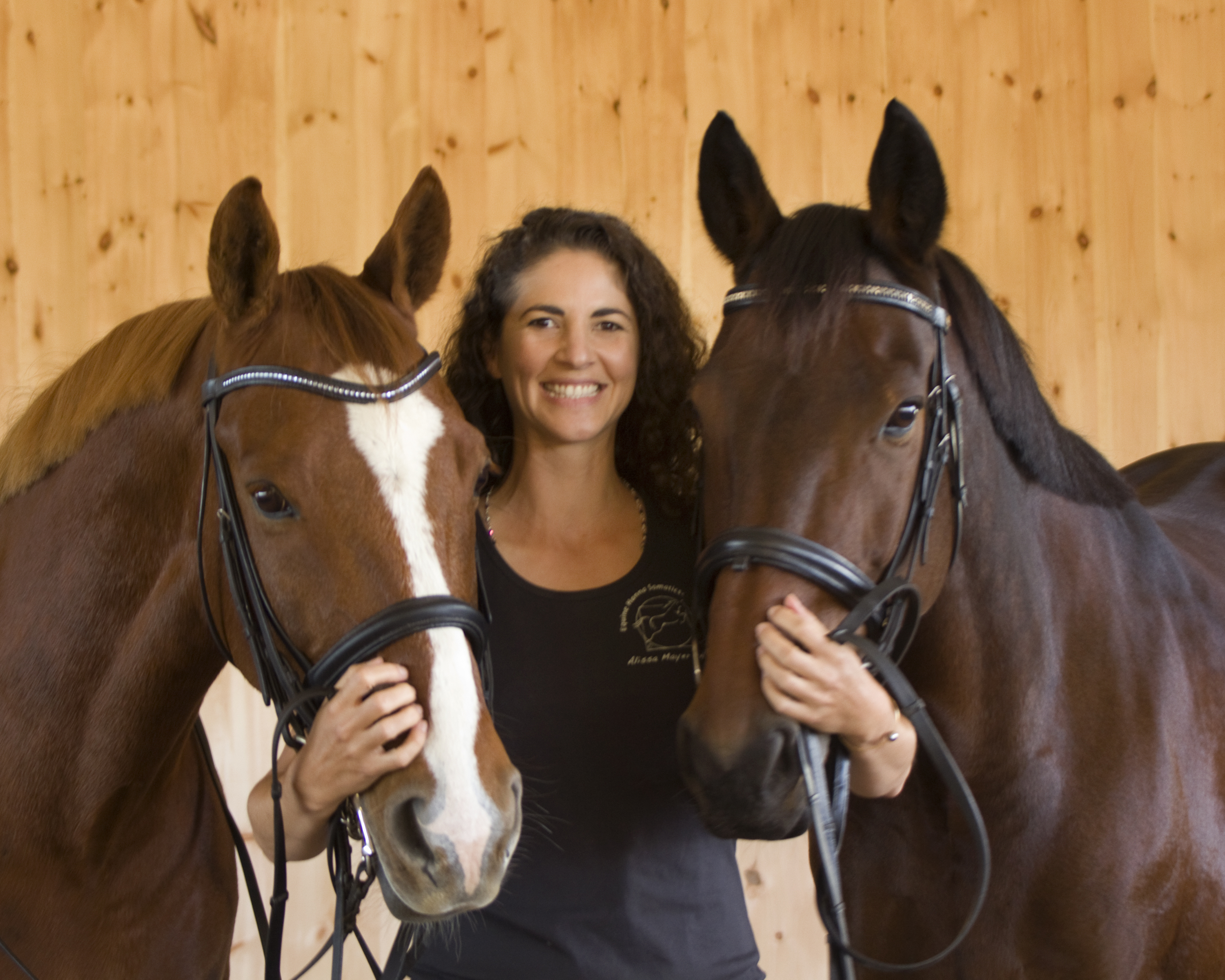
Every horse, at every age and stage, deserves to be happy and comfortable physically in work and in everyday life. Whether we are competitive dressage riders or just lovers of equines, we all want the best quality of life for our horses as well as to see them live up to their athletic potential.
Equine Hanna Somatics® (EHS) is a natural method of mind–body integration for performance enhancement, pain relief, longevity and an increased sense of well-being for both horse and handler. Based on your horse’s natural movements and thought patterns, EHS is a hands-on procedure for teaching horses, along with their riders and handlers, about voluntary and conscious control of their neuromuscular system. It’s gentle enough for every horse at any age or stage of athletic development and can be very complementary to the healing and rehabilitation process once your vet has decided that the horse is ready to begin gentle work post-injury or illness.
EHS is an adaptation of Hanna Somatics®, a proven, natural and safe method of pain relief and sensory-motor training for humans (read “The Training Between Your Training,” Jan. 2016). Like humans, horses experience stress and develop chronically contracted muscles that restrict movement and cause discomfort. Over time, these chronic, low-level muscle contractions, which can also be described as “tension” or “tight muscles,” become incorporated into the horse’s habitual posture. This is known as Sensory Motor Amnesia (or SMA—more on this later). Once this happens, performance and comfort are reduced, and the new postural patterns are difficult to change with physical training or manipulation.
Eleanor Criswell Hanna, co-founder of the Novato Institute, co-creator of Hanna Somatics and creator of Equine Hanna Somatics, has applied the proven method of Hanna Somatics to the horse and discovered that it works just as well, if not better, on the equine body and mind.
From the Horse’s Perspective
Rather than working on the horse’s muscles or adjusting the horse’s body, in EHS practitioners are inviting the horse to participate in the movements by working with them voluntarily. This is a very important point, because for EHS to be effective in helping a horse find and keep new levels of relaxation, the horse must participate in and be allowed to feel the complete experience of using his brain to send instructions to the muscles, feel the muscles move the body and continue to both participate in and receive the sensory feedback from the body during the slow release of the movement. When EHS is done correctly, the horse will use a particular part of his brain—the voluntary motor cortex—to control the muscles during Somatic Movement.
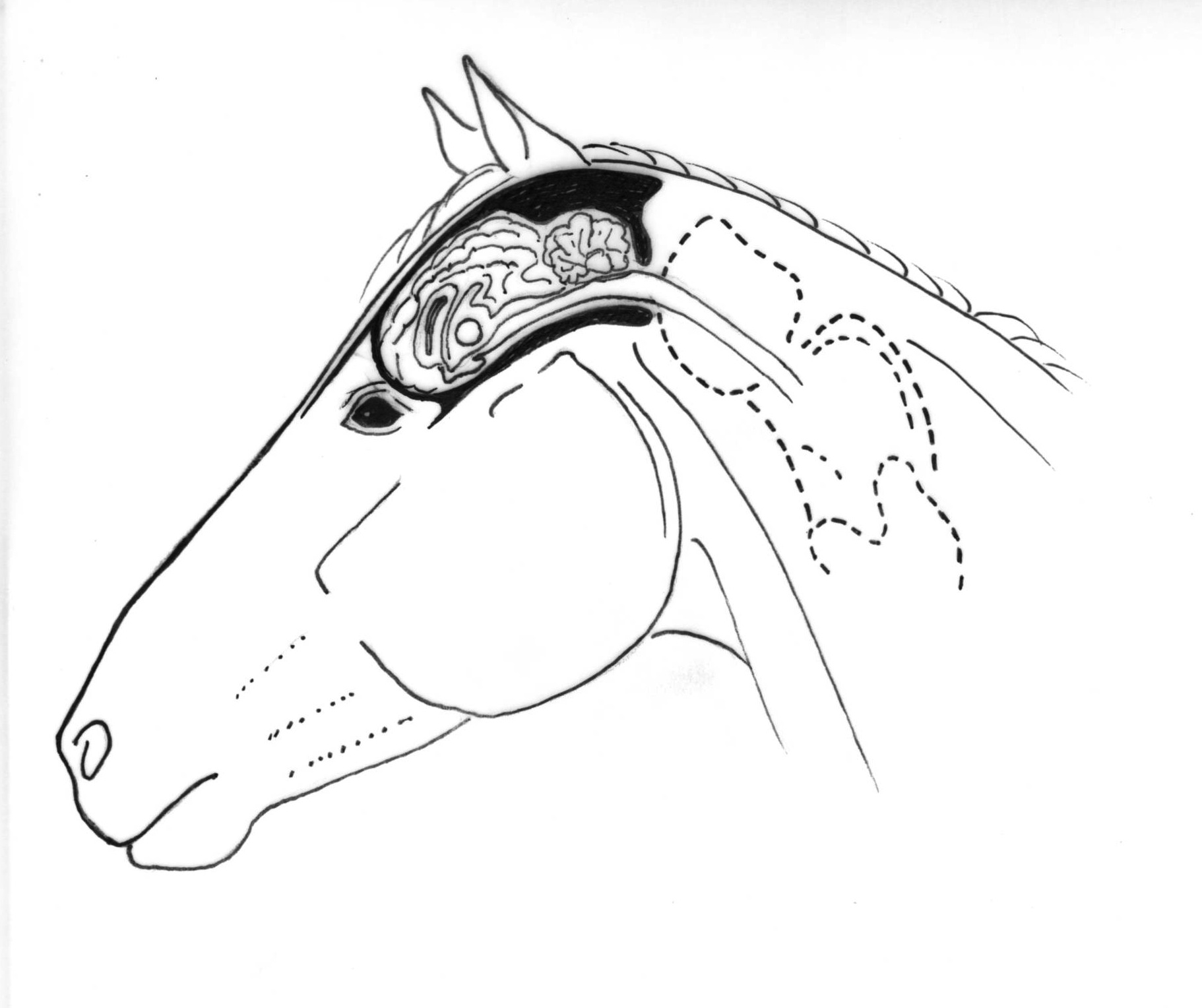
There are many parts of the mammalian brain that can initiate muscle contractions, but the motor cortex is the only part of the brain that can mediate muscle relaxation. What the horse feels during the movement (quick, slow, smooth, jerky, etc.) and the actual impulses sent from the brain to the muscles comprise the information the brain needs to recalibrate how much tension is left in that muscle when at rest—this is called “resetting resting muscle tonus.” From the outside of the body, a practitioner can manually cause a muscle to release, but the brain will often reassert the contraction and the pattern of tension usually returns. By asking the horse to release tension in a muscle from the inside using his or her own central nervous system (the brain and spinal cord), the releases are deeper and usually don’t wear off because the horse has effectively changed his own pattern. (For examples of immediate results with before/after photos of horses, and a few longer-term case studies, visit alissamayer.com/case-studies.)
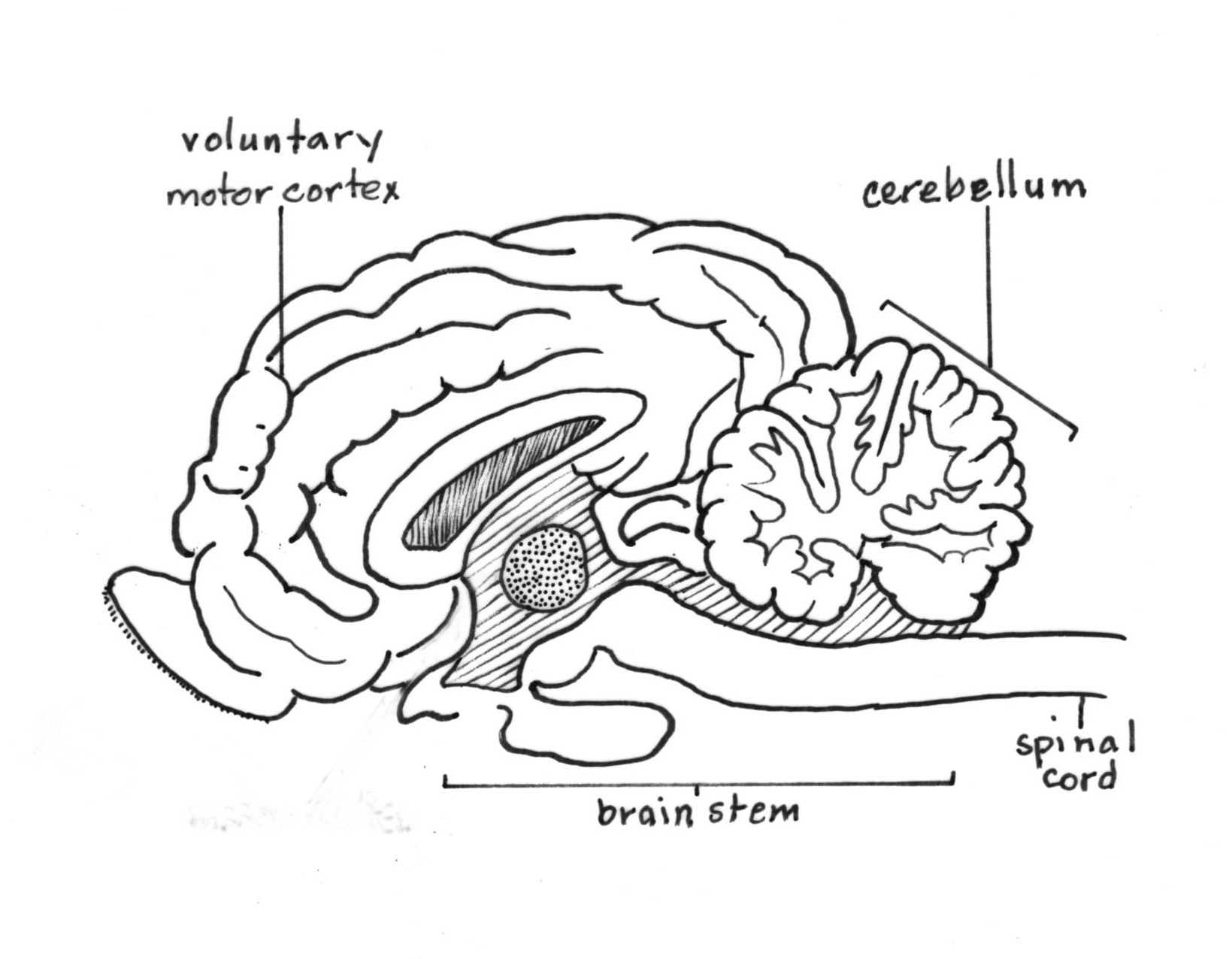
What is Sensory Motor Amnesia?
As a natural consequence of daily living, both horses and humans develop SMA—an accumulation of muscle restrictions that build by degrees as a result of experiencing stress, one-time or ongoing trauma, pain from injury or poorly fitted tack, travel or even just from everyday training. SMA not only limits the ability of the affected muscles to move freely, but it also limits the amount of sensory feedback that the brain is receiving from the affected tissues, affecting body awareness. That old saying, “use it or lose it,” has never been more applicable than to brain cells, neurons and neuromuscular connections.
According to Hanna, SMA refers to unconsciously contracted muscles. Her concept of SMA describes the tendency of humans to forget certain movements or ways of organizing muscles or muscle groups, leaving the muscles chronically contracted. The contraction is the result of ongoing brain-stem-level impulses—in other words, signals from the unconscious part of the brain that are causing the fibers of the affected muscles to contract. Horses also experience unconsciously contracted muscles as a result of the same type of brain-stem-level impulses.
Both the body and the brain adapt to stress as a survival mechanism and these adaptations can become integrated into the brain’s autopilot system. A horse may show adaptations like chronic stiffness, crookedness, weakness or fatigue, a short or uneven stride, a poor attitude, negative behaviors or loss of peak performance. Although SMA cannot be cured by drugs, treatment or surgery, it can be controlled consciously after the relearning process facilitated during an EHS session. The role of EHS is to help a horse recognize inefficient and unconscious muscle contractions so he can regain conscious control over his own muscles and, therefore, also regain access to his full range of motion, strength and endurance.
How Does SMA Happen?
Most people have experienced SMA at some point in their lives. For example, have you ever twisted your ankle or tweaked your knee and found that long after the injury and pain have healed, you were still favoring that leg and not bending that joint all the way? This is an example of an adaptation that was temporarily useful to prevent you from further aggravating your damaged tissues and giving your injury time to heal, but it is persisting as a habit.
A classic example of this in equines is a horse who loses mobility in his hocks. When a limb is overworked or otherwise compromised, the horse’s brain will automatically and unconsciously contract a variety of muscles, some around the injury or fatigue and others that may be far from the site of injury, to stabilize the joints and give the compromised tissues a chance to recover. Just like a person favoring an old injury that has long since healed, many horses continue to hold their limbs stiffly even after the soreness has faded.
Because the human brain (like the horse’s brain) is designed with survival as priority No. 1, it is super efficient. Anything that we repeat frequently enough can be integrated into our autopilot system in a process called “habituation.” Once this happens and we get used to our new normal, we forget what being relaxed and balanced feels like—this is SMA. Think of it as a computer glitch. Accumulate enough chronic muscle tension, and the computer (brain) has to keep several programs running at once, which inevitably slows down performance of both the software and the hardware (the mind and the body). Eventually, the slowdown of performance becomes too much to ignore and we have to restart the computer. If we wait too long, the computer will freeze completely and we have to resort to a forced reboot to override the system. When the system restarts, it runs a diagnostic program and resets everything back to factory settings, aka “neutral.” Nature, in her infinite wisdom, has installed a natural reflex that does this in mammals. It’s called pandiculation and is the reset button of the vertebrate brain.
Pandiculation is a polysynaptic reflex that involves contracting a muscle or group of muscles and then slowly reducing the contractions back to neutral. You have seen a cat or dog pandiculate after waking from a nap—it looks like a full-body stretch, often accompanied by a yawn. Thomas Hanna, PhD, founder of Hanna Somatics, discovered that by intentionally performing this kind of movement, doing a voluntary pandiculation, we cause the brain to do its own diagnostic on the muscles involved and reset the resting level of those muscles back to neutral. When we do EHS, we are working with the horse by asking him to voluntarily pandiculate various groups of muscles. This is what makes EHS unique in the field of mind–body integration, and also extremely effective. Certified EHS educators work with each horse based on his unique postural pattern to alleviate SMA. The takeaway here is that SMA is both reversible and preventable in horses and humans.
EHS can be an enjoyable experience for both the horse and handler, resulting in suppleness and a stronger bond. As a horse relearns how to relax, areas that have been overly tight, circulation and sensation are restored, endorphins are released and the horse becomes relaxed and frequently very sleepy. With regular practice, horses can access their performance potential and maintain a healthy and relaxed state.
Equine Hanna Somatics Exercises
Equine Hanna Somatics (EHS) sessions with a certified EHS educator usually last about an hour. But educators will often teach a horse owner a few basic exercises that can be used as part of a horse’s everyday grooming routine. It should take only a few extra minutes and will be helpful in getting the horse to release tension in many muscles. A horse should not be ridden immediately after doing these exercises, as he will need time to integrate the new way his muscles are feeling and performing. After EHS, owners report that their horses are more relaxed and attentive, respond more easily to the aids and look, feel and perform better. Following are EHS principles to keep in mind.
• The horse must do the work.
• Invite the movement without using force or providing much resistance, only a gentle hands-on feel for direction.
• The horse chooses how far to move—do not ask him to move beyond his current easy range of motion. In EHS, smaller is often better.
• The slow return to neutral is the most important part.
• Do your best to avoid stretching or pulling on the horse. You should avoid stretch because it triggers another involuntary reflex called “the stretch reflex” that affects muscle fibers and tone, and will get in the way of resetting the resting muscle tonus back to neutral.
• Do not use treats. There are two reasons to avoid treats: 1. The addition of food stimulates areas of the brain other than the ones you are trying to target. 2. Horses will reach well beyond their comfortable range of motion to follow or snatch a treat, frequently resulting in the stretching of muscle fibers, which you need to avoid when doing somatic movement.
Remember, the goal is to get the horse to participate mindfully in the movements, not to change the posture or position of his body. The changes in posture will come later, either as the horse integrates the release of tension from this session or in subsequent sessions as he is able to release more and more of the accumulated Sensory Motor Amnesia.
The Initial Pick-Up
Begin with the front leg. Stand beside the horse’s shoulder or hip as if you are preparing to lift the leg to pick out the hoof. Using a gentle touch and steady feel with one or both hands, invite the horse to lift his hoof. Avoid using any familiar or conditioned cues like squeezing the tendons or giving a verbal command to get the horse to lift the hoof, as these are conditioned responses and you want the horse to do a mindful movement.
• If possible, stay connected to the limb as it moves and go only as high as the horse goes easily. Then invite the horse to slowly lower his hoof back to the ground and stand on it. How slowly? As slowly as possible without fighting with the horse or carrying the weight of the leg. For example, try taking a slow breath—inhale and pick up the hoof for two to three seconds, exhale and slowly invite the hoof back down over four to five seconds. That will probably be slow enough, but keep in mind that some horses may take longer or need to stamp the hoof back down quickly to balance. Allow this, remembering that you are targeting the brain and how the horse uses his own leg, not trying to make the leg itself work better or the horse to be more obedient.
• Because the slow return to the ground is the most important part, there is no need to keep the hoof lifted in the air. Once the horse has picked it up, begin the slow return to neutral.
• Repeat each pick-up and slow put-down three times in a row before moving on to the next leg, inviting a total of three pick-ups with each leg.
Each time the hoof comes to the ground, if the horse doesn’t automatically put weight back on the leg, ask him to shift the weight over and stand on that leg. This is to avoid leaving a bit of tension in the deep digital flexor muscle and tendon. Do not force the horse. If he is refusing or cannot cooperate for some reason, simply move on to the next leg and try again tomorrow.
Below, Alissa Mayer demonstrates the Initial Pick-ups. The height of the pick-ups will vary based on the horse’s comfort, trust and range of motion.
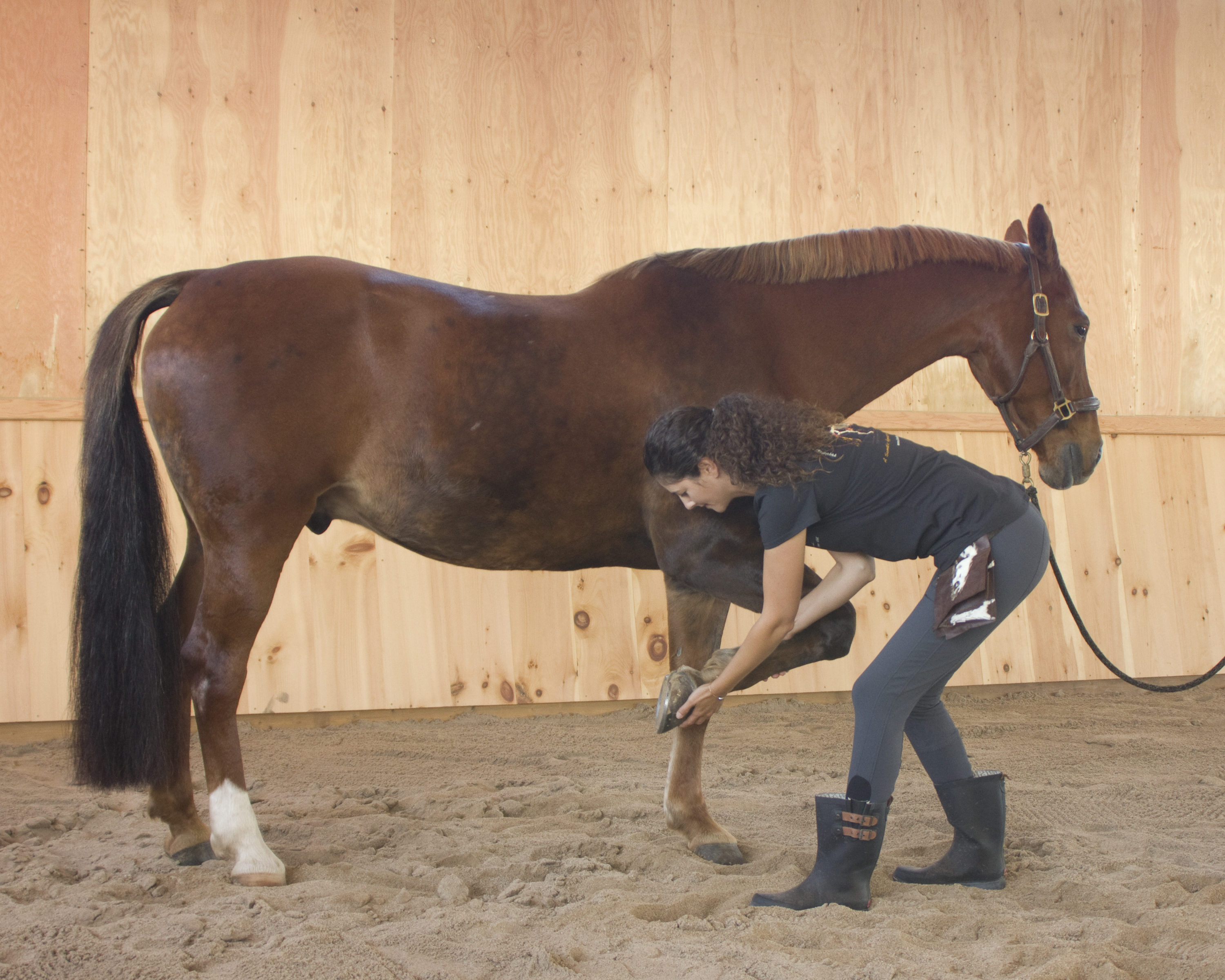
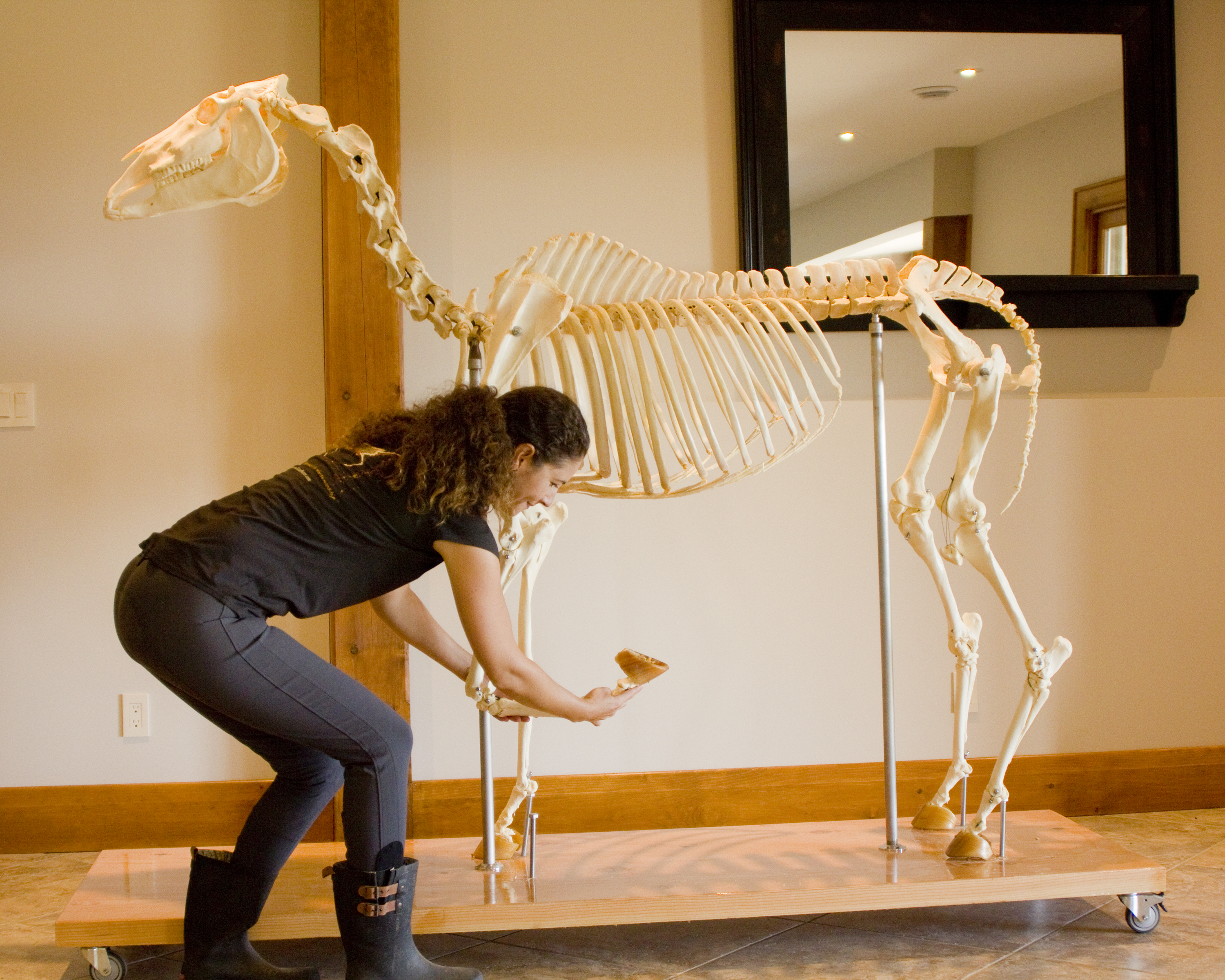
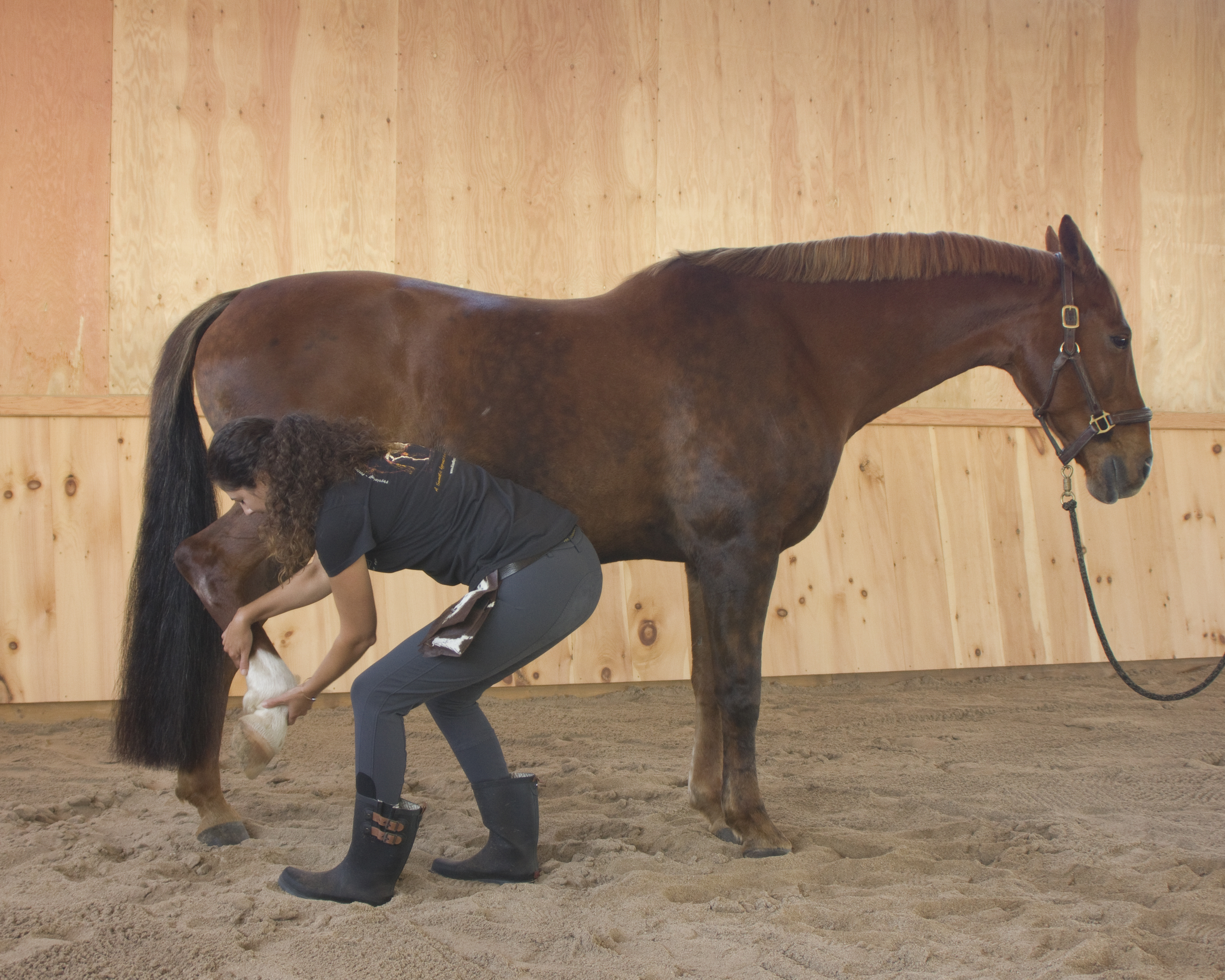
Lateral Flexion of the Neck
Begin on the side that the horse tends to bend most easily toward. If you aren’t sure which is the easy side, begin on the horse’s left side.
• Stand beside the horse’s neck/shoulder and place your hands on his head or halter—whatever is most acceptable to him.
• Using gentle pressure with your hands, step back to create space as you invite the horse to turn his head and neck toward you in lateral flexion. Only invite the horse as far as he can go easily and not beyond the point at which the ears tilt and the horse twists at the poll or neck. Remember, this is not a stretch.
• Maintain your gentle hold on the horse’s head and invite him to slowly straighten back toward a neutral head and neck position. Do not fight if the horse needs to move quickly, just begin again.
• Invite the horse to repeat the movement on the same side three times, then walk around to the other side and repeat.
Below, Mayer prepares to invite this mare to do Lateral Flexion of the Neck to the right (A), but only as far as she can easily go (B).
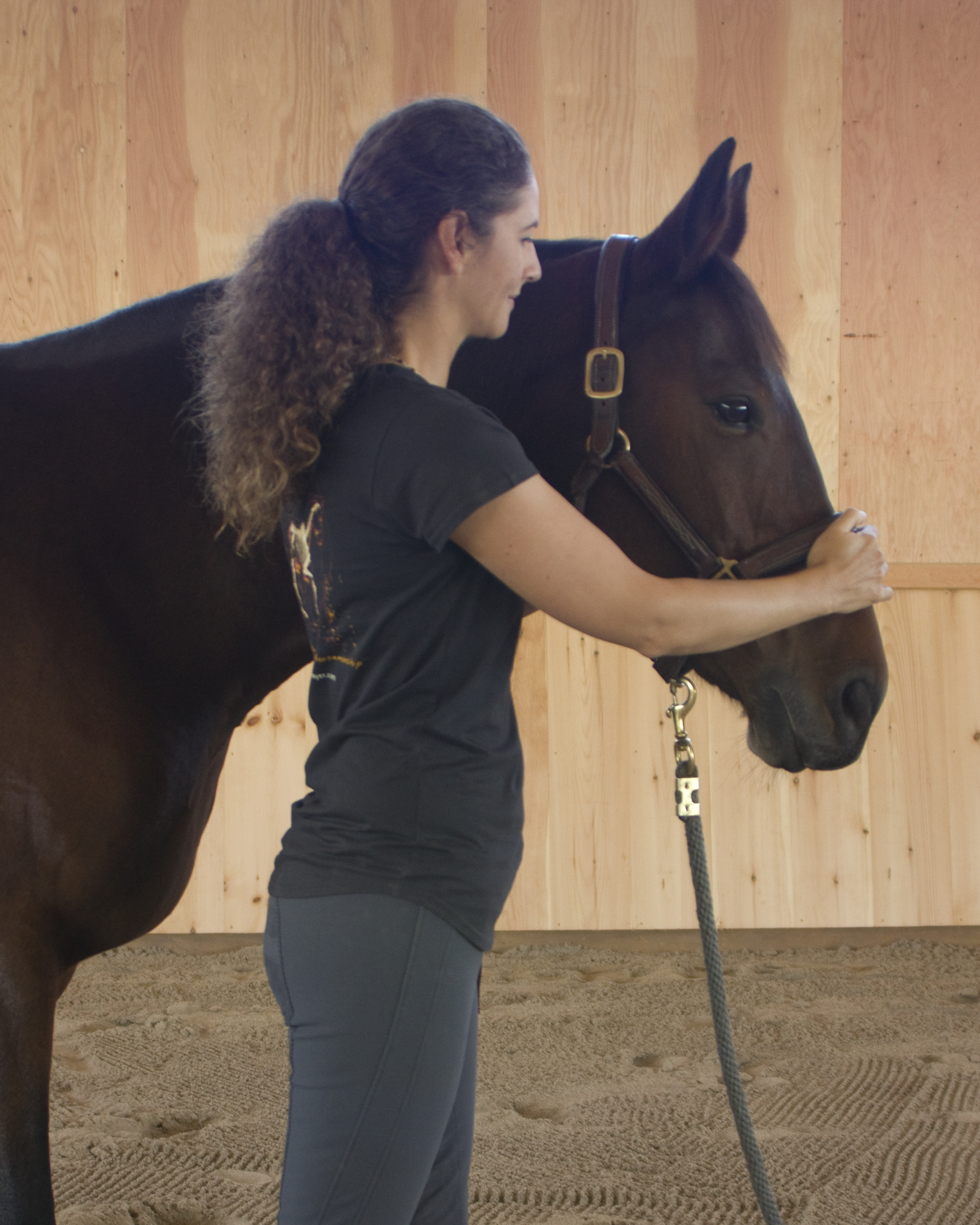
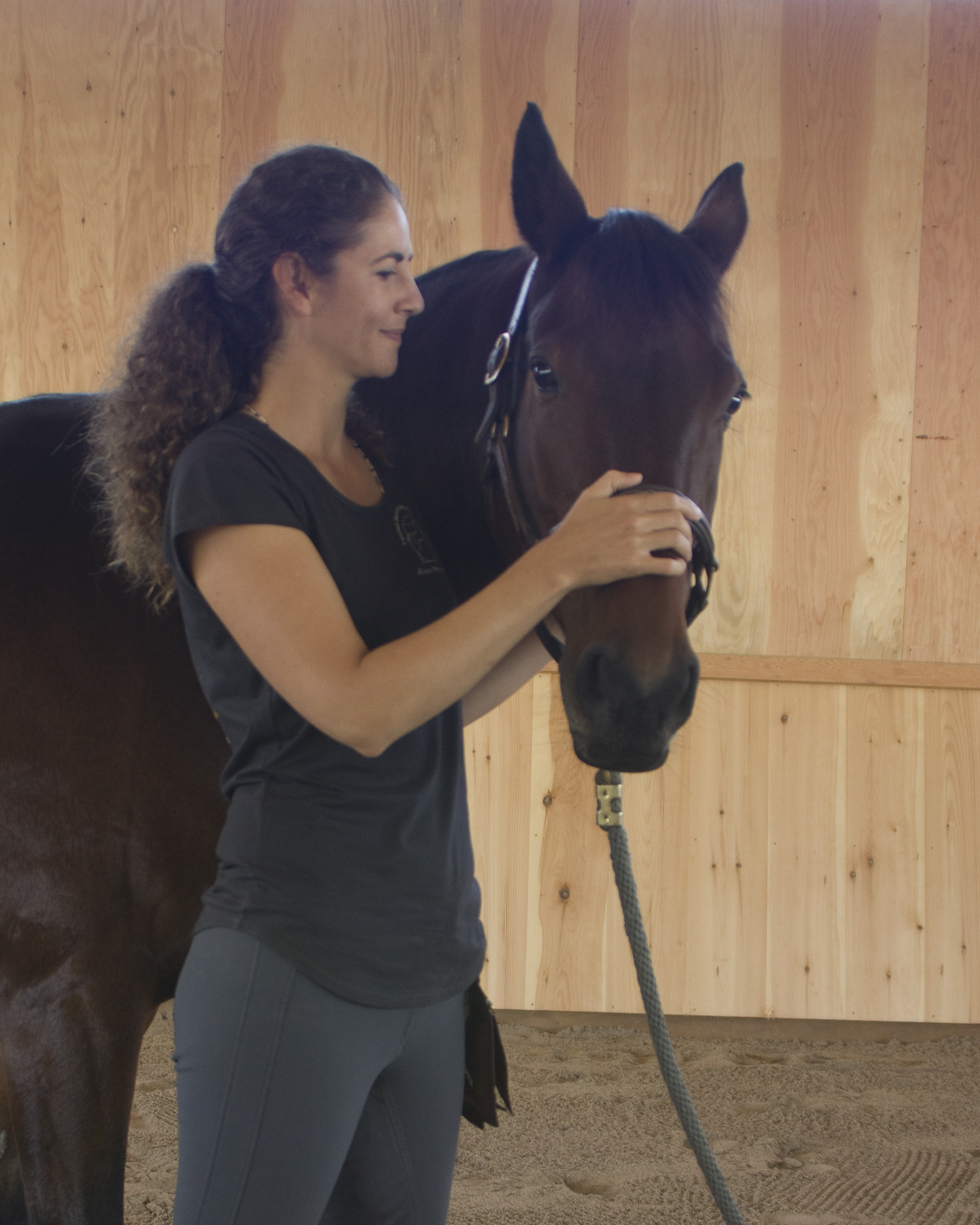
Horses will often yawn during EHS. Wait until the horse is finished yawning before continuing with the next repetition or exercise.
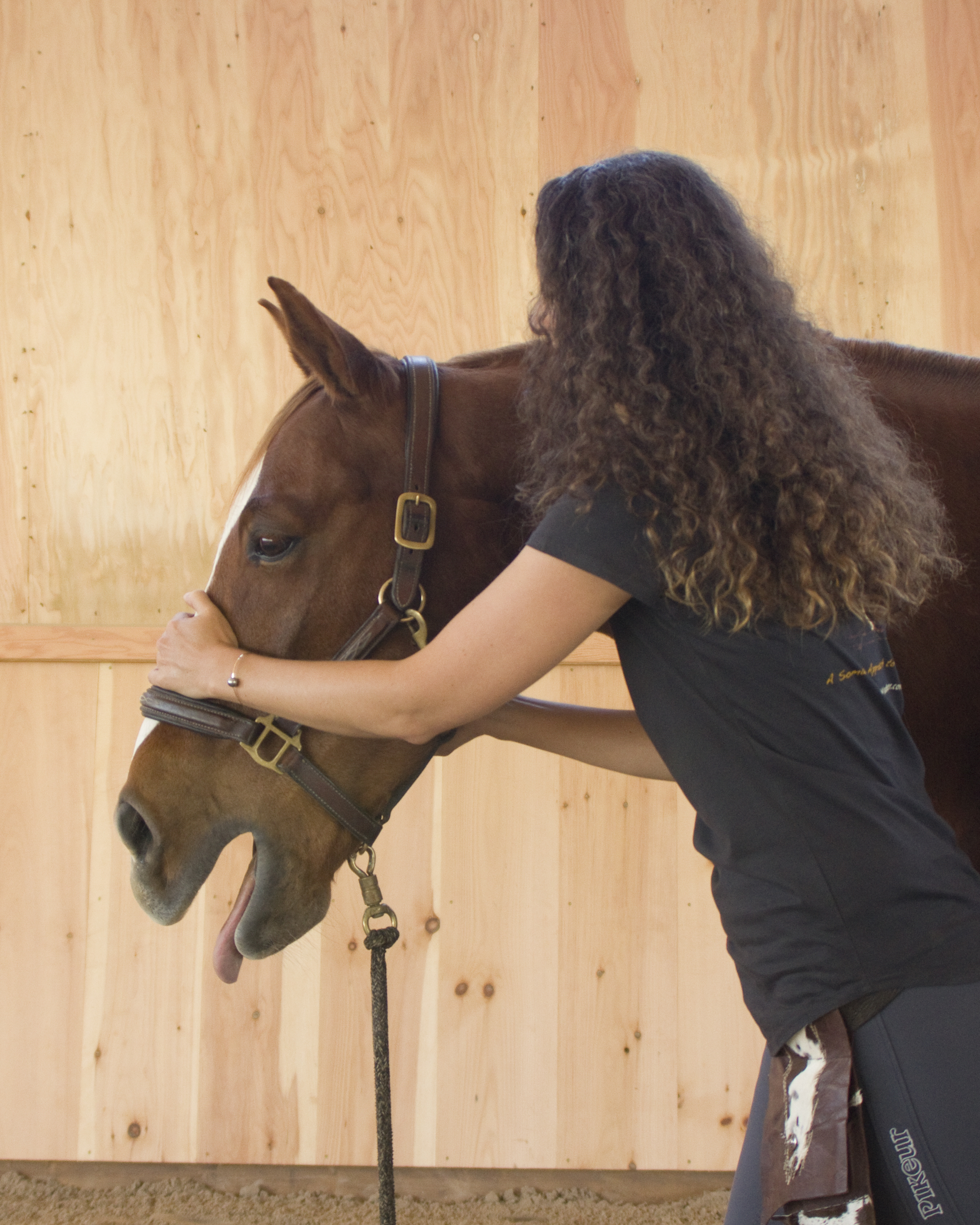

EHS is very difficult to do wrong because you are carefully asking the horse to move his own body only as much as he can do easily and comfortably. If you succeed in communicating to your horse that cooperation and the slow return to neutral are essential ingredients to this short session, then you are doing it right. It is not necessary to look for any particular responses from the horse to confirm that you are doing EHS correctly, because you are working with simple, pure physiology. EHS works whether the horse tells you he feels it happening in the moment or not. Typical responses from the horse that can be seen in longer sessions include licking, chewing, yawning, blowing out and relaxing, showing changes in position, movement and posture. Over time, the movements become easier for the horse to do, the limbs will become feather-light and the horse will have an expanded range of motion. Some horses may feel very relaxed or sleepy even after just these two movements. Other horses may feel energized and ready to move.
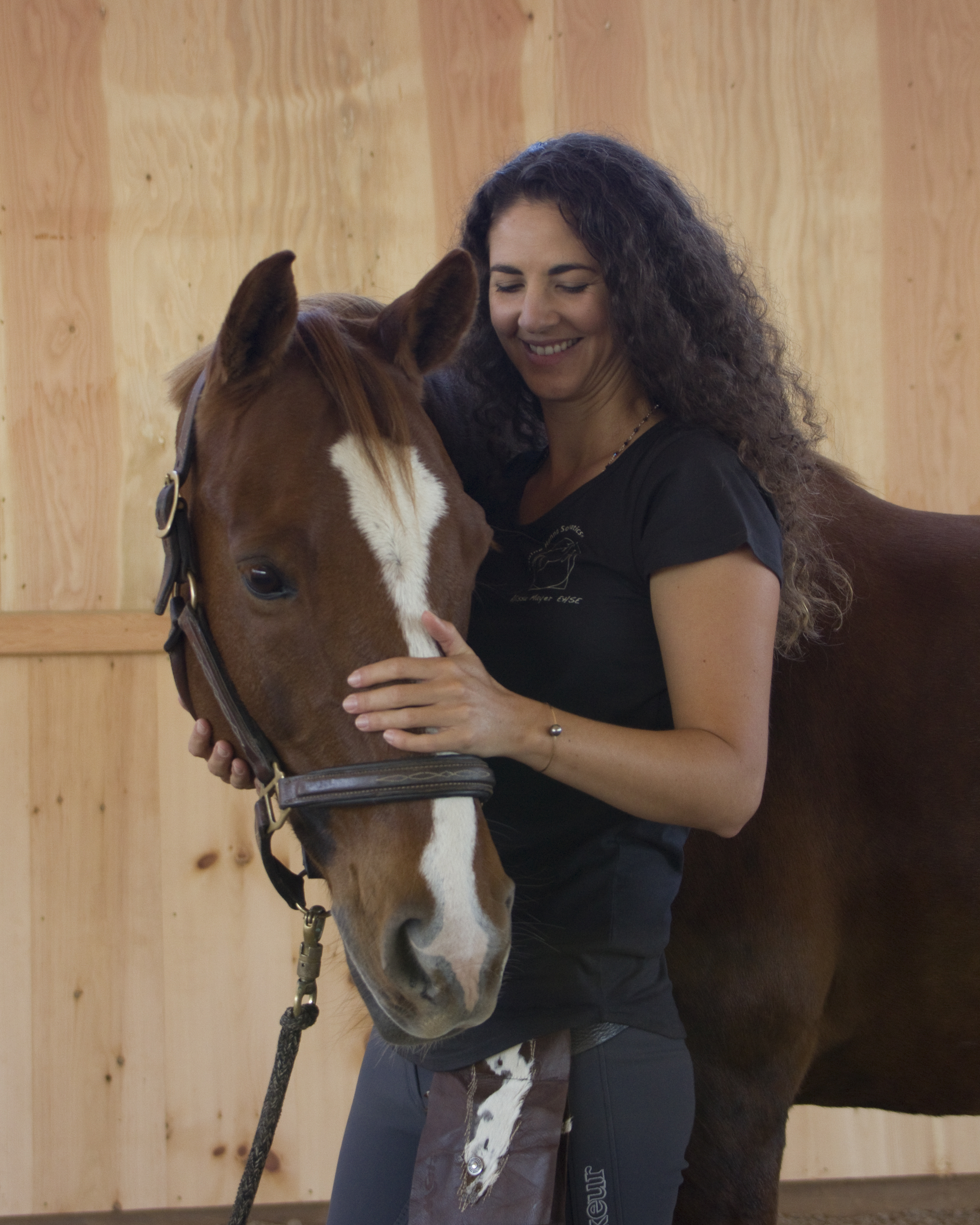
If you’re interested in learning how to do a complete introductory session from our instructional video “Equine Hanna Somatics Session 1,” visit equinehannasomatics.com.
Alissa Mayer has a bachelors of science degree in equine science, is a certified Equine Hanna Somatics® Educator and the creator of A Somatic Approach to Horsemanship™. She works with horses and riders to help them regain their natural balance, alignment and range of motion to optimize performance potential and well-being. Learn more at alissamayer.com.
EHS: A Tool for Developing Suppleness and Relaxation
By Sarah Martin
Dressage done right is a study in the fine-tuning of the balance point between horse and rider. In my opinion, Equine Hanna Somatics (EHS) is another major tool in resetting the balance for both horse and rider.
As a rider and trainer who is constantly observing my horses (and my students’ horses) for progress that is achievable by normal humans and normal horses—not super athletes and not people who have all day to devote to one horse—I have found that the time I invested to learn how to use EHS with Alissa Mayer, certified Equine Hanna Somatics Educator based in Oregon, has enhanced my relationship with my horse. Learning EHS has also increased my awareness of where the horse’s body may not be cooperating or available and given me tools to help my horse access those parts.
What I found the most intriguing in the EHS work with my horses was how much the methodical progression through the body mirrors good dressage training and thereby facilitates the progression of training for the horse’s whole body. On the Training Scale, two of the trickiest ingredients to define and develop are Suppleness and Relaxation. Any athlete or trainer understands that a tense muscle will not be supple. But less understood is the link between mental and physical relaxation. The study and practice of EHS allows the body and mind to build awareness and explore range of motion in all four legs, the spine and in the major muscle groups of the hindquarters, back, shoulders, neck, poll and jaw.
As a rider who can compare how my horse feels both before and after EHS work, what I find is that the sessions do seem to profoundly affect my horse’s ability to accept connection through his or her body as well as to access areas of tension that exercises under saddle have failed to alleviate. An equally intriguing aspect of Hanna Somatics (HS) is that the person who practices EHS with her horse can also pursue HS for herself. Not surprisingly, there are frequently parallel restrictions that the rider may find and free in her own body by practicing HS. Most importantly, in my view, is that a rider can feel how this slow release through range of motion can greatly improve the rider’s own body, balance and feel.
Sarah Martin is a USDF gold medalist and Certified Instructor through Fourth Level and a USDF instructor/trainer faculty member.
Real-Life Benefits of Hanna Somatics
By Felicitas von Neumann Cosel

For many years, I had searched for a solution to my chronic back pain that threatened the end of my riding career. Almost three years ago I found Hanna Somatics (HS). This approach to gentle body movements has not only made an amazing difference in my ability to manage my back pain, it has made an enormous difference in my riding position.
After my first few sessions, I learned that there was HS for horses—Equine Hanna Somatics (EHS). At the time I was riding Tonico do Top, a very successful 15-year-old Lusitano stallion, in his last season at Grand Prix. He was not a big mover by nature, therefore it took years to develop him in an athletic way so he was able to flow with cadence and jump. He always had to work hard to stretch his physical limitations and I was always looking for ways I could help him.
As much as HS was helpful for me, I was very doubtful how it could work with a horse. But curiosity and intrigue won over doubt, so I ordered the DVD for EHS. Watching it, I was still very skeptical, but since I had taken it that far I thought I might as well give it a try. I started with the leg lifts for Tonico. It took me exactly one round of lifting his legs and I could not believe how much it reflected everything I felt when I rode him. For example, in the right-lead canter he would come down too fast on his right front leg, which took away some of the flow and was obvious to me in the flying change to the right. When I tried to work with his leg lift in the right front he was not able to put it down slowly and softly. Once Tonico relearned to let that front leg down smoothly, his canter and the flying change to the right improved greatly. There were many other things I found working with his hind legs, back, neck and ribs. It was an enormous time commitment, but I could feel an improvement in Tonico under saddle right away. I also found that EHS exercises became an invaluable tool at horse shows, when Tonico would be very tight after shipping.
The more I worked with Tonico, the more I realized that I did not know enough about the approach and, unfortunately, there wasn’t anyone in my area teaching it. I decided to reach out to the founder, Eleanor Criswell Hanna, thinking all she could do was not answer if she thought I was too forward. It turned out that she was most gracious and lovely, immediately willing to answer my questions. Later that fall she actually traveled to the East Coast to spend a couple of days working with the horses and me.
EHS is a wonderful tool that really is available to anyone. In my case, I know it was a huge contributing factor for Tonico to be able to go on and finish his last show season, becoming BLM Grand Prix Champion for a fourth year in a row, BLM Grand Prix Freestyle Champion for the third time and a repeat winner of the GAIG Grand Prix Freestyle Championship.
Felicitas von Neumann Cosel is a top international Grand Prix trainer, rider and coach who has trained out of First Choice Farm in Maryland for the last 34 years. Winning many championships on all levels, she is mostly known for her beautiful position and ability to train horses in classical self-carriage.
This article first appeared in the January 2018 issue of Dressage Today.





